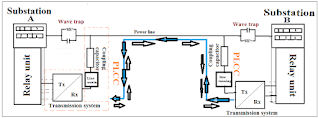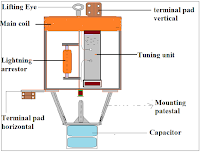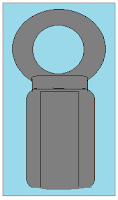In this article, I have explained some topics related to wave traps.
- What is the Line trap or wave trap?
- What is the purpose of the Wave trap in the substation?
- Where to connect or mount the wave trap at the substation?
- What are the tests to be done on the wave trap in the substation?
What is the wave trap?
A wave trap is a special preventive device that is installed on a power line to keep high-frequency waves away from devices that work with low-frequency waves. It acts like a guard, making sure that the fast waves don't get into the equipment that only handles slow waves. The wave trap usually looks like a cylinder, similar to a tube. Its shape helps it do its job effectively and keep the different types of waves separated.
The other common names of wave traps are line trap or High-frequency stopper (2Khz to 250Khz).
Due to its blockage of high frequency, we can say that the wave trap is a low pass filter or band block filter.
In one line, a wave trap or line trap is used to trap waves of high frequency above 50 Hz.
Wave trap- Sectional view design
Top view of the wave trap
What is the function of wave trap in substation?
We already know that wave traps are designed to block high frequencies, thereby preventing the entry of high-frequency signals (ranging from 30 kHz to 200 kHz) into low-frequency equipment (such as 50 Hz equipment).
What is Low-Frequency in substation?
Low-frequency equipment is an electrical equipment that can withstand only 50 Hz or 60 Hz. The equipment s like the main bus, transformer, circuit breakers are designed in such a way that allows only 50 Hz or 60 Hz.
What is High frequency in substation?
Transmission of the high-frequency waveform in the power line is due to carrier communication between two substations. At the time of communication, the high frequency will generate. So high-frequency waveform is called "carrier communication frequency".
The substation over 66kv uses a wave trap to filter "carrier communication frequency".
We can use a line trap or wave trap along with the electrical equipment CVT (Capacitive voltage transformer.
Wave trap or Line trap Symbol
The circuit diagram of Wavetrap is the symbol of the wave trap. In fact, the circuit diagram is a parallel resonance circuit.
The circuit diagram of the wave trap consists of 4 main components, and each plays an important role.
- Inductor coil.
- Series resistance.
- Capacitor.
- Lightning arrestor.
A brief explanation on wave trap or Line trap circuit diagram
The circuit of the wave trap looks like a parallel resonance circuit (R-L-C circuit) connected in series to the terminals of the transmission line. The circuit act as a low-pass filter circuit.
We all know that the power line only carries 50 Hz. Then, "where did the high-frequency come from?". This is because of power line carrier communication (PLCC).
For understanding better the wave trap, know about PLCC power line carrier communication. I must explain it to you.
Wave trap in PLCC
PLCC is a big concept, so I tried to explain how and when high-frequency produces in PLCC.
The PLCC is a carrier communication line that helps to transmit the information or data of one substation to another substation.
For detail, If substation A and Substation B are connected with the PLCC system, then these two substation can communicate easily. If substation-A protective relay tripped due to some fault, then it sends a signal to Substation B about the status of Substation A.
This communication or status is helpful for the automotive devices to perform their specified task.
PLCC is used for telecommunication between two or more electrical substations.

For detail, consider the two substations (Substation-A and Substation-B) are distant from 500km apart. Each substation has its own protective equipment such as a protective relay, circuit breaker, backup protection.
The substation-A transmits power to substation-B through the A.C power lines. If the circuit breaker became open at substation A, then it sends information to substation B.
These two substation protective devices communicate with each other and share information about the actual status of a substation.
When PLCC is in operation or in communication, it produces a high-frequency (3 Khz to 800 Khz). In modern days substations are using wireless communication through an antenna.
To protect the electrical equipment, engineers will install wave traps at the terminals of the power line to prevent the entry of high-frequency into high voltage electrical equipment such as the main busbar, circuit breaker, power transformer, distribution transformer, instrument transformer.
The wave trap is used to trap the waves of the high-frequency signal which flows in the transmission line. The wave trap is suitably designed to divert the high-frequency communication signal to the PLCC (power line carrier communication) panel with the help of a Capacitor-Voltage Transformer (CVT).
Major components of wave trap or Line Trap
The major components involved in the line trap or wave trap are
- Main coil
- Line tune
- Protective device
Main coil
We make the main coil of the wave trap or line trap with stranded aluminum cable (Al) it functions as an inductor coil. It can withstand maximum rated current and maximum short circuit current.
While designing the 'main coil of the wave trap' the designer should also consider the following factors insulation, temperature stress, insulation of coil, losses, and weight, etc.
Line tune
The line tuner of the wave trap helps to tune the carrier frequency range. Line tuner of the wave trap connected series to the coupling capacitor. They produce a high impedance for low frequency. Obviously, it opposes the flow of power line frequency, into the PLCC room or panel.
Protective device
A lightning arrestor or surge arrester is provided along the wave trap to protect it, from the lightning surge and the wave trap is designed with a bird barrier, to protect the line trap or wave trap from the entry of birds.
The line trap or wave trap is an outdoor protective type device, so there is a high possibility of damage to external weather conditions, or birds can sit on a wave trap and can short-circuit the wave trap.
By considering all these effects, the manufacturer's provided with a protecting device.
The working function of the wave trap
Wave trap functions as a low-pass filter to stop high-frequency waveform. The two ends of the Transmission line (The transmitting end and receiving end) are mounted with a wave trap.
The wave trap is a device capable of creating high impedance to the carrier frequencies. The wave trap act like a big size choke coil. It allows only low frequency (50 Hz) to the desired components.
The inductor and capacitor in the line-trap circuit are low-pass filters. The engineers design the circuit of the wave trap to provide a low impedance path to power frequency (50Hz) and high impedance to the carrier communication frequency (3kHz to 250 kHz).

The inductor coil produces high-inductive reactance to the high-frequency.
XL=2. π. f. l
At the same time, the capacitor produces low capacitive reactance for increased high-frequency.
Xc=1/2. π. f. l
The high inductive reactance is nothing but a high impedance, which is against frequency. The low capacitive reactance produces low impedance against frequency.
For increased frequency increased inductor coil is required. So they design the inductor coil in enormous size.
The coupling capacitor is used to link the PLCC panel and power line. It provides low impedance for the high-frequency carrier signal.
The high impedance of the wave trap cancels the high frequency. So that entering of high-frequency to the electrical component is prevented.
Mounting of Wavetrap
What is Mounting?
Mounting is nothing but the installation of the wave trap in a right place. The mounted wave trap should withstand any stresses and in harsh weather. So the wave trap is mounted suitably.
Different ways to mount wave trap or Line trap
- Suspension mounting
- Horizontal mounting
- vertical mounting
- CVT head mounting
Wave trap lifting lug
For suspension mounting, they provided a lifting eye or lifting lug in the upper portion of the wave trap. The industries normally make lifting eyes in the steel material.
Horizontal and vertical mounting
The horizontal and vertical mounting is normally done with the help of a mounting pedestal which is attached at the bottom of the wave trap.
CVT head mounting
They design the mounting pedestal for the wave trap to fit above the CVT (capacitive voltage transformer).
Wave trap reduces Corona loss
The ionization of the air or moisture around the power transmission line because of decay in the electric field system around the conductor.
The transmission of high-frequency in the power line increases the corona loss or corona effect. The corona loss produces glow and hissing noise in the transmission line and leads to a wastage of power.
By considering the corona effect wave trap is designed to reduce corona loss in a transmission line with the help of a corona ring.
Corona loss occurs in both AC and DC transmission lines. But in DC, corona loss is less.
Manufacturer's of line trap or Wavetrap
Testing of wave trap
At the substation, the testing engineers should test the wave trap before erection and commissioning.
Testing of wavetrap
The following test to be done on the line or wave trap are
- Measurement of inductive reactance of the inductance coil or main coil
- Insulation test for lightning arrester
- Contact resistance test for the connector
- Insulation test on terminals of wave trap or line trap
- Measurement of temperature test
- Withstand time of short-circuit current
- Voltage test (corona and radio interference voltage measurement).







Thank you so much for this information. if you want to buy Rectifier Transformer in India, Visit Transformer Manufacturers in pune, One of the best Transformer Manufacturers in India.
ReplyDeleteThank you so much for this information. If you are looking for Transformers Manufacturers in Pune , You may visit Trutech Products, One of the best Transformer Manufacturers in India.
ReplyDeleteParaflex is the Best Cable Company in India. Today Paraflex is the most favourite brand because it provides high-quality products at affordable prices and available all over India.
ReplyDelete